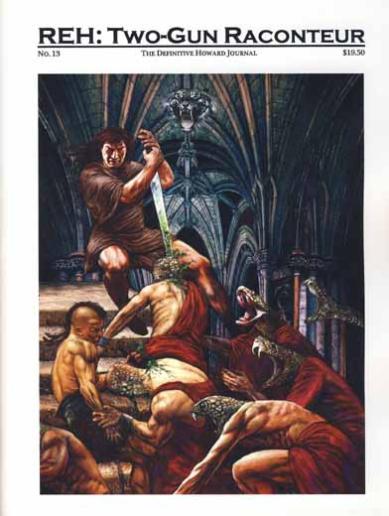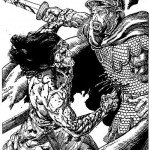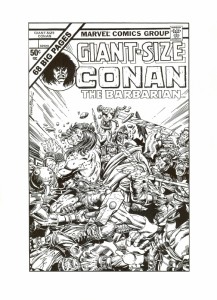A Review of REH: Two-Gun Raconteur #13
Wednesday, July 15, 2009
posted by Deuce Richardson
 Print This Post
Print This Post
My copy of REH: Two-Gun Raconteur #13 came in the post on the same day that a long-awaited guest arrived. Due to previously scheduled essays, I’m only now getting around to singing this issue’s praises. Morgan Holmes has already weighed in on the REHupa site, but I hope that this review will complement his.
I must admit that I never read the earlier issues of “TGR” when they were published back in the 1970s. I was but a wee lad back then. However, I have perused the “Out of Print” section on Damon C. Sasser’s website. REH: Two-Gun Raconteur has always been a worthy publication, mixing real Howardian scholarship, quality art and fannish fun. That was definitely my impression when I bought the first “relaunch” issue in 2003.
REH: Two-Gun Raconteur #13 greets you with a full-color cover depicting Kull and Brule whaling away at serpent-men. Sasser went with color covers (one of the advancements of civilization we can all be thankful for) a while back. That move got my unequivocal support at the time, and this cover changes that opinion not one whit.

The classy cover illustration is by Nathan Furman, whose career I’ve been following for a couple of years. His mastery of painting has steadily improved and this piece is a good example of that. The layout conforms to the classic “Frazetta pyramid” schema, and that ain’t a bad thing. The colors are vibrant and rich. The throne-room has a good Gothic feel, one more in line with Howard’s medieval sympathies and sensibilities than the Classical look so many artists have gone with in earlier Kull-related artwork. On the downside, Kull’s couture might have been a bit more interesting and I think that if REH intended Brule to have a Mohawk ‘do he would have said so. Still, Nathan’s Brule is so much closer to REH’s description than that of Dark Horse’s “Pictafarian” (as Steve Tompkins would say) version of the Spear-Slayer that I’m willing to cut the man some slack. Another cool thing to see is serpent-men with actual serpents’ heads, as opposed to the “reptilian-rat-Nosferatu” look of the Dark Horse comics.
The inside front and back covers are rendered by TGR veteran, Joe Wehrle. They both do a good job of depicting scenes from REH’s finest Western, “The Vultures of Wahpeton.” This yarn has not received the illustrative love it deserves in years past. I especially like the dramatic and atmospheric inside front cover piece.
Sasser’s editorial, “Brother, can you spare some escapism?”, is well-written and timely. Reading it, I was taken back to the very early 1980s when money was short, but used REH paperbacks were everywhere.
As usual, TGR serves up a hard-to-find Howard rarity with “The Black Moon.” Full disclosure: Thanks to Glenn Lord and Zebra Books, I read my first Steve Harrison yarn before I ever read a Conan tale by Robert E. Howard. Prior to receiving this issue, I’d never read “The Black Moon.” I like it. This short (six pages) tale demonstrates that Harrison kept faith with friends regardless of race, color or creed. The ending has a decent twist. As much as anything, I enjoyed the mention of Pan Chau in the fourth paragraph, which indicates that REH might have read Wells’ classic, A Short History of the World. One wonders what other mayhem and bloodshed the eponymous “Black Moon” engendered both before and after it crossed Harrison’s trail.
Turning to page 19, we are presented with, “The Hyperboreans Re-Imagined,” by Morgan Holmes. Holmes delineates the many discrepancies betwixt how REH actually described the northernmost Hyborians and how de Camp and Carter portrayed them in stories like “Legions of the Dead” and “The Witch of the Mists.” A topic that definitely deserves a closer look.
Next up is “The Long and Winding Road: A Poetic History.” Former Cimmerian blogger, [redacted], details the long journey necessary to bring The Collected Poetry of Robert E. Howard to fruition. He starts with REH’s childhood and ends with the triumph that is the Robert E. Howard Foundation’s The Collected Poetry of Robert E. Howard.
Damon Sasser almost always gives his readers a Howard-related portfolio to savor, and this issue carries on that tradition. “Kings of the Night: A Bran Mak Morn Portfolio” by Michael L. Peters is a good ride. Peters got the cover slot of the last TGR with an accurate portrait of Sonya and Von Kalmbach. It  is always a tricky thing to try and spot an artist’s influences. To me, Peters does a good job of combining Buscema’s vigor and Barry Windsor-Smith’s latter-day inking style. Peters should be applauded, if nothing else, for illustrating the charge of the Dalriadian Gael, Cormac na Connacht, the unsung hero of “Kings of the Night.”
is always a tricky thing to try and spot an artist’s influences. To me, Peters does a good job of combining Buscema’s vigor and Barry Windsor-Smith’s latter-day inking style. Peters should be applauded, if nothing else, for illustrating the charge of the Dalriadian Gael, Cormac na Connacht, the unsung hero of “Kings of the Night.”
Frank Coffman contributes two poems. One is “Birth,” inspired by the crystallization of Conan in Howard’s mind while on a trip to Fredericksburg, Texas.
“The Skald and the King” by Chris Green looks at the similarities in the styles, careers and outlooks of Howard and comic artist, Jack Kirby. When I was  younger, I had a hard time dealing with Kirby’s art. However, as the years have gone by, I’ve had to aknowledge Kirby’s raw artistic power and his ability to portray structures, vistas and beings of cyclopean and, oftentimes, truly cosmic proportions. Every day, there is a comic being published that owes something to Jack Kirby. The same could be said of Robert E. Howard in the fantasy field.
younger, I had a hard time dealing with Kirby’s art. However, as the years have gone by, I’ve had to aknowledge Kirby’s raw artistic power and his ability to portray structures, vistas and beings of cyclopean and, oftentimes, truly cosmic proportions. Every day, there is a comic being published that owes something to Jack Kirby. The same could be said of Robert E. Howard in the fantasy field.
Brian Leno, no stranger to the readers of The Cimmerian journal nor of REH: Two-Gun Raconteur, presents another fine essay entitled, “Kingdoms of Clouds and Moonmist: Casual Observations on the Harold Lamb Influence in the Crusader tales of Robert E. Howard.” Leno does a good overview of the subject; one which begs for more such essays.
Next is ” ‘Sailor’ Steve Costigan: A Portfolio” by Clayton Hinkle. Hinkle manages to convey the brutish charm, humor and dynamic fights inherent to the Costigan yarns, in my opinion.
Last, but by no means least, is “The Mighty Revelator Passes.” Nine pages of eulogies for the late, great Steve Tompkins. Most contributors had written something elsewhere (and done it well), but I was especially pleased and enlightened to read the tributes from former Cimmerian blogger, [redacted], and from the godfather of Howard studies, Don Herron. A heart-felt final word from Sasser wraps it up.
REH: Two-Gun Raconteur has always been a journal worth buying. I will go on record as saying that this is the best issue ever. So far.
